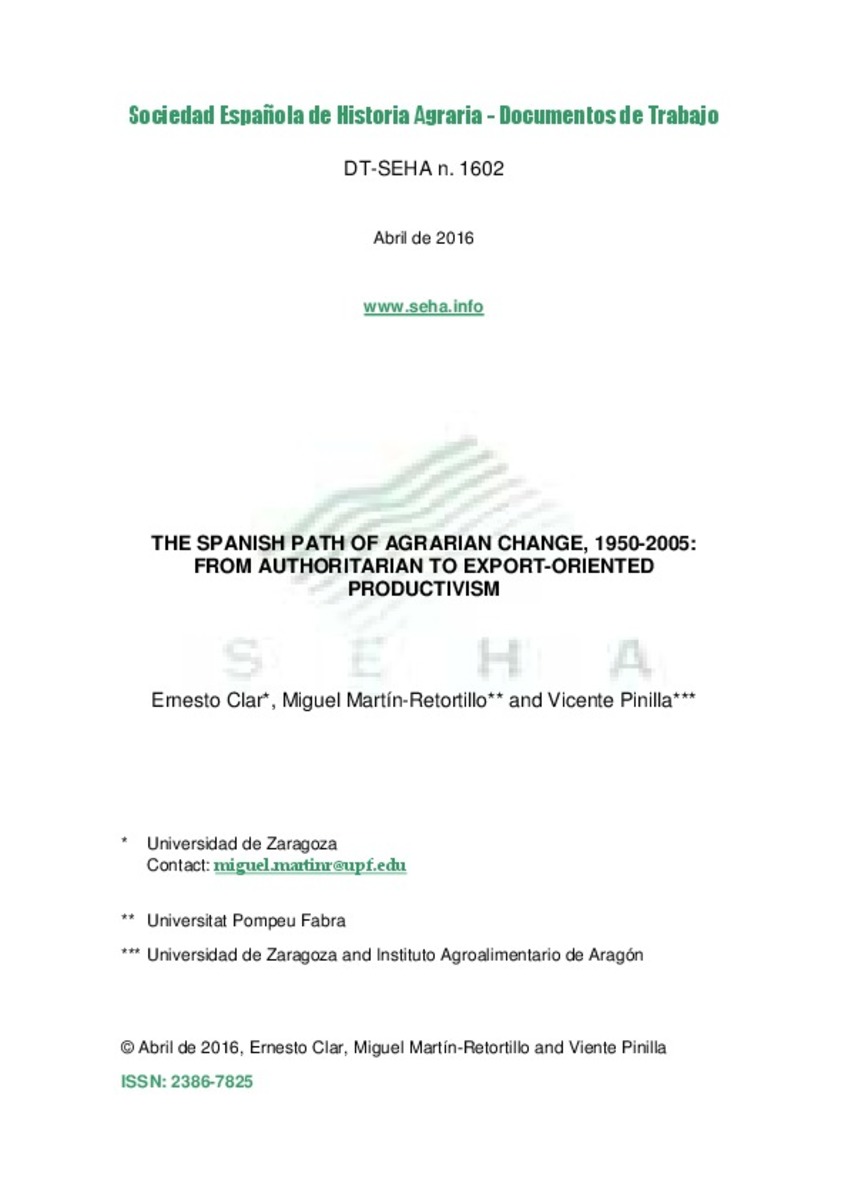Mostra el registre parcial de l'element
The Spanish path of agrarian change, 1950-2005: From authoritarian to export-oriented productivism
| dc.contributor.author | Clar, Ernesto | |
| dc.contributor.author | Martín-Retortillo, Miguel | |
| dc.contributor.author | Pinilla, Vicente | |
| dc.date.accessioned | 2016-04-20T06:51:10Z | |
| dc.date.available | 2016-04-20T06:51:10Z | |
| dc.date.issued | 2016-04 | |
| dc.identifier.issn | 2386-7825 | |
| dc.identifier.uri | http://hdl.handle.net/10234/158884 | |
| dc.description.abstract | The aim of this study is to determine whether the Spanish path of agrarian change, between 1950 and 2005, exhibits some features important enough to differentiate it from the common model of developed countries in Western Europe. On the one hand, the Spanish agrarian transformations share the main features which took place in Western Europe: technological innovation, increased production and productivity, loss of importance of the agricultural sector, tight integration with the industrial sector and, finally its high impact on the environment. On the other hand, a series of important peculiarities can be observed in the Spanish agrarian change: strong expansion of intensive livestock farming; importance of increased irrigation to explain the transformation of agriculture; policies that offered very little support to the agricultural sector under a dictatorship that denied a voice to farmers; maintaining a very prominent role in the economy despite its small contribution to GDP. | ca_CA |
| dc.description.abstract | El objetivo de este trabajo es comparar el modelo de cambio agrario español entre 1950 y 2005 con el predominante en los países europeos occidentales en el mismo periodo. Nuestras conclusiones ponen de relieve que ambos comparten las mismas características principales: innovación tecnológica, incremento de la producción y la productividad, pérdida de importancia relativa del sector agrario, fuerte integración con el sector industrial y alto impacto medioambiental. Sin embargo, el cambio agrario en España ha tenido una serie de peculiaridades destacadas, como son la fuerte expansión de la ganadería intensiva, la creciente importancia del regadío para explicar las transformaciones agrarias, unas políticas públicas que ofrecieron un escaso apoyo al sector agrario bajo una dictadura que impedía la participación de los agricultores en el diseño de las políticas agrarias y el mantenimiento de un papel destacado del sector a pesar de su pequeña contribución al producto interior bruto. | ca_CA |
| dc.format.extent | 38 p. | ca_CA |
| dc.format.mimetype | application/pdf | ca_CA |
| dc.language.iso | eng | ca_CA |
| dc.publisher | Sociedad Española de Historia Agraria | ca_CA |
| dc.relation.isPartOfSeries | Documentos de Trabajo; 16-02 | |
| dc.rights | © Abril de 2016, Ernesto Clar, Miguel Martín-Retortillo and Viente Pinilla | ca_CA |
| dc.rights.uri | http://rightsstatements.org/vocab/InC/1.0/ | * |
| dc.subject | Agricultural change | ca_CA |
| dc.subject | European agriculture | ca_CA |
| dc.subject | Agricultural policies | ca_CA |
| dc.subject | European economic history | ca_CA |
| dc.subject | cambio agrario | ca_CA |
| dc.subject | agricultura europea | ca_CA |
| dc.subject | políticas agrarias | ca_CA |
| dc.subject | historia económica europea | ca_CA |
| dc.title | The Spanish path of agrarian change, 1950-2005: From authoritarian to export-oriented productivism | ca_CA |
| dc.type | info:eu-repo/semantics/workingPaper | ca_CA |
| dc.subject.jel | N54 | ca_CA |
| dc.subject.jel | O13 | ca_CA |
| dc.subject.jel | Q18 | ca_CA |
| dc.rights.accessRights | info:eu-repo/semantics/openAccess | ca_CA |
Fitxers en aquest element
Aquest element apareix en la col·lecció o col·leccions següent(s)
-
DT_SEHA [102]
Documentos de Trabajo de SEHA







